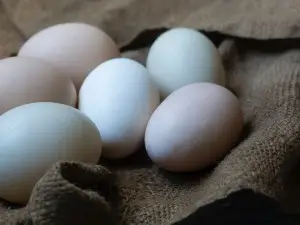
Hatching eggs can be an exciting experience, but this doesn’t mean that it won’t also be nerve-wracking. This article looks into everything you need to know about duck eggs internally pipping
Table of Contents
Internally pipping duck eggs
There are a few stages that ducklings go through before finally hatching. One of the first stages is internally pipping. Here is what you need to know about this stage:
What is internally pipping?
Duck eggs are made up of the shell of the egg, the duckling inside, an air sac that makes up about a third of the space inside the egg, and a membrane separating the duckling and the air sac.
There is no air on the side of the baby duck during embryo development. Air will only crossover to the duckling side, and the duckling will only start to breathe, once it internally pips.
Once the egg has been incubated for about 24/25 days the duckling in the egg will ‘internally pip’.
Internally pipping describes the act where a bird breaks the membrane that separates it, and the air sac. Once the membrane is broken the bird can take its first breath of air.
You won’t be able to see what’s going on inside of the egg at this stage but the bird will start to make vocalizations and tap on the egg shell after internally pipping. You’ll be able to hear the bird if you hold the egg up to your ear.
You’ll be able to see what’s going on inside of the egg if you candle it. Candling involves shining a torch light or a candle behind the egg to see inside.
External pip and zip:
The next stage of the egg hatching process is the external pip, this is where the bird breaks the shell of the egg with its beak. This external pip can happen 12 to 24 hours after the internal pip.
The bird should start to “zip” the eggshell (crack the shell open along the large side of the egg) 12 to 48 hours after the initial external pip. This zipping will only take a few hours, or less, to complete.
Once the egg is wholly zipped the bird will quickly pop the shell off and emerge from the shell.
Hatching is a lot of work for ducklings, birds will move very slowly and make small movements during the hatching process.
The bird will crack some of the shell, take a breath, take a rest, and then try to break through the egg again until it has fully hatched.
The egg will wiggle and roll while the duckling is trying to hatch out of the egg.
What to do:
If the duckling internally pipped then you can leave the egg alone. You may become anxious at this stage and want to help the bird but you shouldn’t. The bird should be given time to come out of its shell on its own.
Only help the bird out of its shell if the baby bird is not zipping out of the egg and no progress is being made on the bird’s side to get out of the egg.
Helping the bird get out of its shell should only be done if you see a good reason to. Prematurely helping the bird get out of its egg, or doing so in a rough way, will be detrimental to the bird.
You may need to help the duckling out of its egg if the bird pipped on the wrong side of the egg (the small side). Hatching out of the small side of the egg will be difficult and the bird may need help to do this
If you’re incubating mallard duck eggs, and the egg has been in the incubator for a long time, more than 28 days, then check on the duck by candling it.
Candling is when you shine the light of a torch, or a candle, against the back of the egg to see inside of the egg. If the bird is alive then the bird will move in the egg or make sounds while being candled.
However, some duck eggs take longer to incubate, muscovy ducks take 35 days to start hatching, let these birds be.
If you enjoyed this article then you may also be interested in other duck related articles. Here are some articles that you may be interested in: Duckling Breathing Heavy, Duckling Umbilical Hernia, Why Do Ducks Kick Eggs Out Of A Nest, Duck Wheezing,

